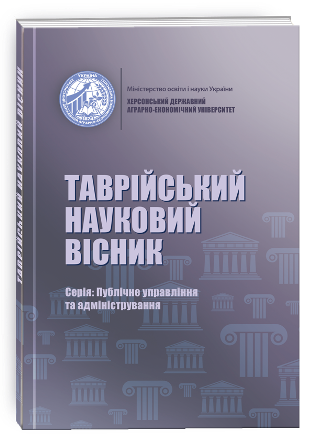PROBLEMS OF ESTABLISHING EFFECTIVE INTERACTION OF DISTRICT STATE ADMINISTRATIONS AND LOCAL GOVERNMENTS OF TERRITORIAL COMMUNITIES IN THE CONDITIONS OF THE NEW ADMINISTRATIVETERRITORIAL SYSTEM
DOI:
https://doi.org/10.32851/tnv-pub.2021.3.17Keywords:
decentralization, local governments, local state administrations, administrative- territorial structureAbstract
The article considers the main problems of establishing effective interaction of district state administrations and local governments of territorial communities in the conditions of the new administrative-territorial structure. The main results of the end of decentralization reform related to the liquidation and reorganization of districts in Ukraine are available, and the first analytical conclusions has been made. As a result, local community managers and local government officials have moved to a new format of relationships that is not enshrined in law. In practical terms, changes in the administrative-territorial structure, the main functions and powers of local governments and local state administrations in the new conditions, the possibility of an effective and efficient combination of national and local interests are described. It is noted that further use of the disproportionate and archaic Soviet model of administrative- territorial organization as the foundation of irrational organization of power causes a conflict of competences between local governments and local administrations, which in turn leads to inefficient management of socio-economic development in relevant territories. The list of factors that cause difficulties in the relationship between district state administrations and local governments and the main problems associated with their impact. The main possible models and mechanisms for balancing both systems of government at the legislative level have been identified and analyzed. According to the analysis and identification of the main problematic aspects of cooperation between different representatives of the local authorities, ways to overcome them are outlined for the most effective performance of such interaction.
References
Сисоєва В.Г. Актуальні питання взаємодії органів місцевого самоврядування та місцевих державних адміністрацій. Наукові записки Національного університету «Острозька академія». 2012. № 3. С. 151–158.
Децентралізація дає можливості. URL: https://decentralization.gov.ua/news/13350/ (дата звернення 02.12.2021).
Про утворення та ліквідацію районів : Постанова Верховної ради України від 17 липня 2020 р. № 807-IX. URL: https://zakon.rada.gov.ua/laws/show/807-20#Text (дата звернення 03.12.2021).
Гончарук Н.Т. Взаємодія органів державної влади та органів місцевого самоврядування: правові та функціональні аспекти. Теорія та практика державного управління. 2011. № 1. С. 321–329.
Пyблiчнa aдмiнicтpaцiя в Укpaïнi: cтaнoвлeння тa poзвитoк / за заг. peд. A.B. Toлcтoyxoвa, H.P. Hижник, H.T. Гoнчapyк. Днiпpoпeтpовськ : Moнoліт, 2010. 400 c.
Монастирський Г.Л. Координація управлінської діяльності органів представницької та виконавчої влади в процесі забезпечення сталого розвитку громади. Перспективи розвитку освіти, науки і бізнесу в глобальному середовищі : матеріали VIII Міжнародної науково-практичної конференції (Тернопіль, 23 жовтня 2020 р.). Тернопіль : ФОП Осадца Ю.В., 2020. С. 64–65.
Адміністративно-територіальний устрій України. Шляхи реформування : монографія / В. Яцуба, В. Яцюк, О. Матвіїшин та ін. Київ : Геопринт, 2007. С. 366.
Шкуріна Л.Б. Аналітичний звіт за результатами оцінювання ефективності застосування окремих законодавчих актів щодо децентралізації влади в Україні. URL: http://komsamovr.rada.gov.ua/uploads/documents/42258.pdf (дата звернення 04.12.2021).






